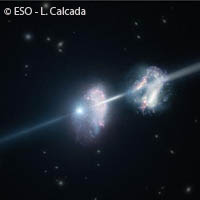Gamma-ray bursts help reveal make-up of distant galaxies
Space scientists investigating the composition of very distant galaxies have discovered two galaxies in the young Universe that have more heavy chemical elements than the Sun. Led by the Max Planck Institute for Extraterrestrial Physics in Germany, the international team used a short yet brilliant light of a distant gamma-ray burst for its study. According to the astronomers, a merger of the two galaxies is potentially on the cards. Events like these in the early Universe can help create new stars and may be the trigger for gamma-ray bursts. These bursts are associated with exceptionally energetic explosions observed in distant galaxies, and are the most luminous explosions in the Universe. Astronomers say they are initially identified by orbiting observatories which detect the initial short burst of gamma rays. Once their positions are found, researchers then assess them using large ground-based telescopes with the capacity to detect the visible-light and infrared afterglows that the bursts emit over a number of hours and/or days. The Very Large Telescope (VLT) of the European Southern Observatory gave the team the means to study a burst, called GRB 090323, a day after it exploded. The National Aeronautics and Space Administration (NASA) Fermi Gamma-ray Space Telescope first identified this burst, which was then spotted by the X-ray detector on NASA's Swift satellite and with the Gamma-Ray Burst Optical/Near-Infrared Detector (GROND) system at the MPG/ESO 2.2-metre telescope in Chile. According to the scientists, the bright light from this burst moved through two galaxies: its own host galaxy and one nearby. Both galaxies are viewed as they were some 12 billion years ago, and the chances for such distant galaxies to be caught in the glare of a gamma-ray burst are rare indeed. 'When we studied the light from this gamma-ray burst we didn't know what we might find,' says Sandra Savaglio of the Max Planck Institute for Extraterrestrial Physics. 'It was a surprise that the cool gas in these two galaxies in the early Universe proved to have such an unexpected chemical make-up. These galaxies have more heavy elements than have ever been seen in a galaxy so early in the evolution of the Universe. We didn't expect the Universe to be so mature, so chemically evolved, so early on.' Faint galaxies would not be visible if gamma-ray bursts were absent. When the light from a gamma-ray burst moves through the galaxies, the gas there acts like a filter and takes up some of the gamma-ray-burst-generated light at certain wavelengths. An assessment of the 'fingerprints' from the various chemical elements allowed the researchers to determine the composition of the cool gas in these distant galaxies. According to them, they are very rich in heavy elements. They also anticipate that galaxies in the young Universe will contain smaller amounts of heavier elements than present-day galaxies, like the Milky Way, possess. The team says a number of galaxies were already very rich in heavy elements less than 2 billion years after the Big Bang. Their work shows that the two young galaxies are likely creating new stars at a remarkable rate, to enrich the cool gas robustly and quickly. The merger of both galaxies could trigger star formation upon collision of the gas clouds. The team's findings give weight to the theory that gamma-ray bursts could be linked to the creation of vigorous massive stars. 'We were very lucky to observe GRB 090323 when it was still sufficiently bright, so that it was possible to obtain spectacularly detailed observations with the VLT,' says Dr Savaglio. 'Gamma-ray bursts only stay bright for a very short time and getting good quality data is very hard. We hope to observe these galaxies again in the future when we have much more sensitive instruments; they would make perfect targets for the [European Extremely Large Telescope (E-ELT)].'For more information, please visit: Max Planck Institute for Extraterrestrial Physics:http://www.mpe.mpg.de/main.htmlESO:http://www.eso.org/public/
Countries
Germany



